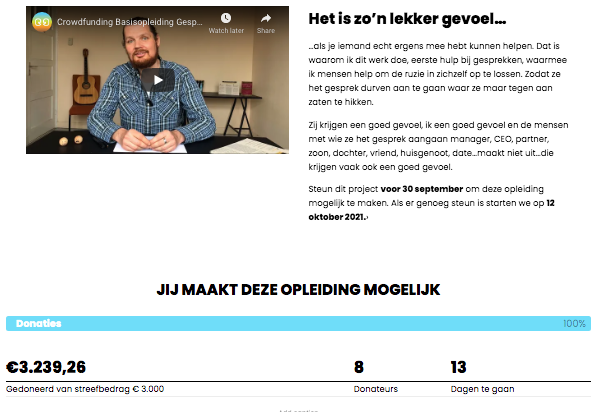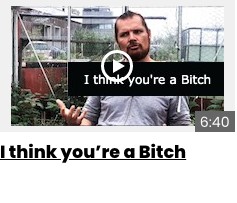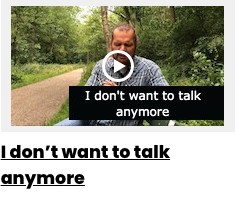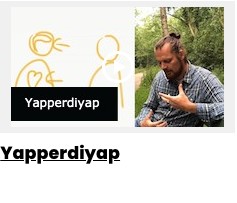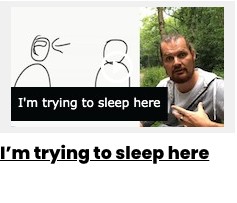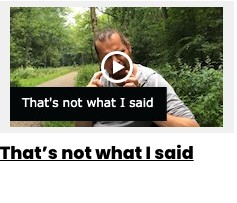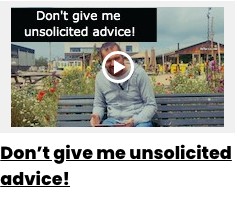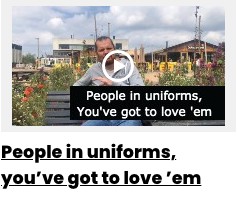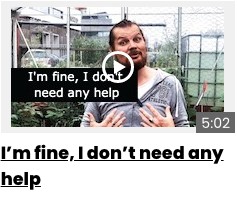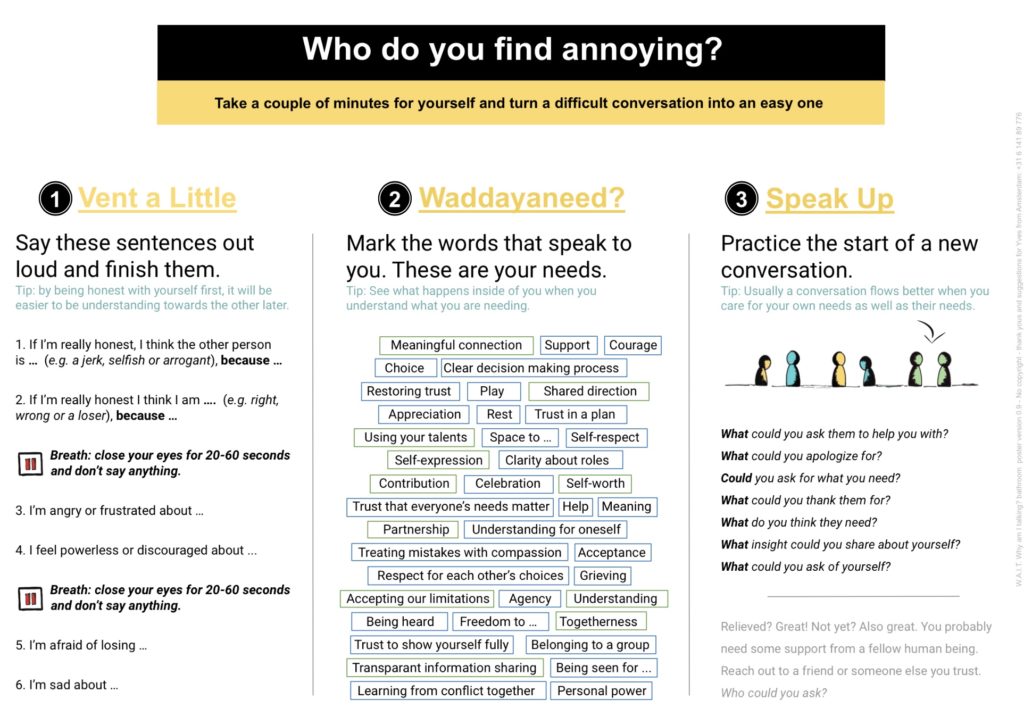Student of nonviolence in everyday and extraordinay life
Updates
on my adventures with nonviolence
- Publishing Pause
Hi there,
I’m taking a moment to inform you that things are mostly going according to plan. I’m teaching 1-2 times a week, I’m practicing conversations with people and I’m creating weekly videos as well.
There is a group of about 13 people that are practicing with me. These are people that have done the 10-week course Eerste Hulp bij Gesprekken. I’m currently focusing most of my attention on supporting this group. To create a solid foundation for a flourishing movement of Eerste Hulp bij Gesprekken and The Tiny Peace office.
Because I have physical limitations, this focus means that, right now, I say no to writing and publishing publicly.
I plan to publish publicly again somewhere before the end of the year.
There is a way to get access to what I’m publishing and that is to signup for a 10-week course at www.eerstehulpbijgesprekken.nl
Because I care about the impact my decision has on you: will you let me know if you have any concerns, requests or frustrations about what I’m writing here?
With kind regards, from Amsterdam,
Yves
- Deze week bij Eerste Hulp bij Gesprekken #2
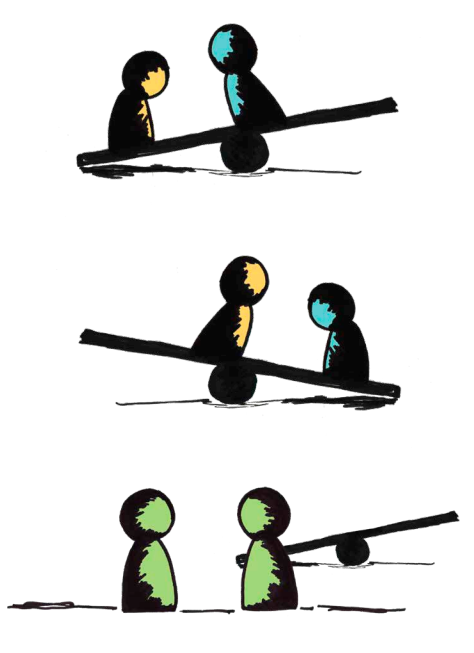
Deze krijg je, omdat je hebt aangegeven lid, begeleider in opleiding of begeleider te willen worden. Wat ons bindt, is dat we dagelijks oefenen om onszelf niet groter of kleiner te maken, maar vanuit een gelijkwaardige en open houding te leven. Deze week een videoclip, een concept-website voor Eerste Hulp bij Gesprekken, meer info over de verdiepingsochtend, Martin Luther King en een voorstel strategie 2022. Ejoy.
Moe en voldaan,
Yves - Protected: How can I speak up with an open heart in the heat of the moment?This content is password protected.
- Project Update: Tiny Peace Office website
After a couple of very helpful conversations with Wendela, Lukas, Minouk & Jeantilette, I’ve gotten the clarity I needed to create a website for the Tiny Peace Office. For now, the website is in Dutch, as I’m focusing on creating the first-ever Tiny Peace Office in Amsterdam.
The Tiny Peace Office is a location in the neighborhood, where people can get the support they need to restore a relationship that has been damaged by conflict. The location is being accompanied by a website, where people can get the same service online.
The vision is to co-create a network of Tiny Peace Offices, built by local peacemakers around The Netherlands…and the globe.
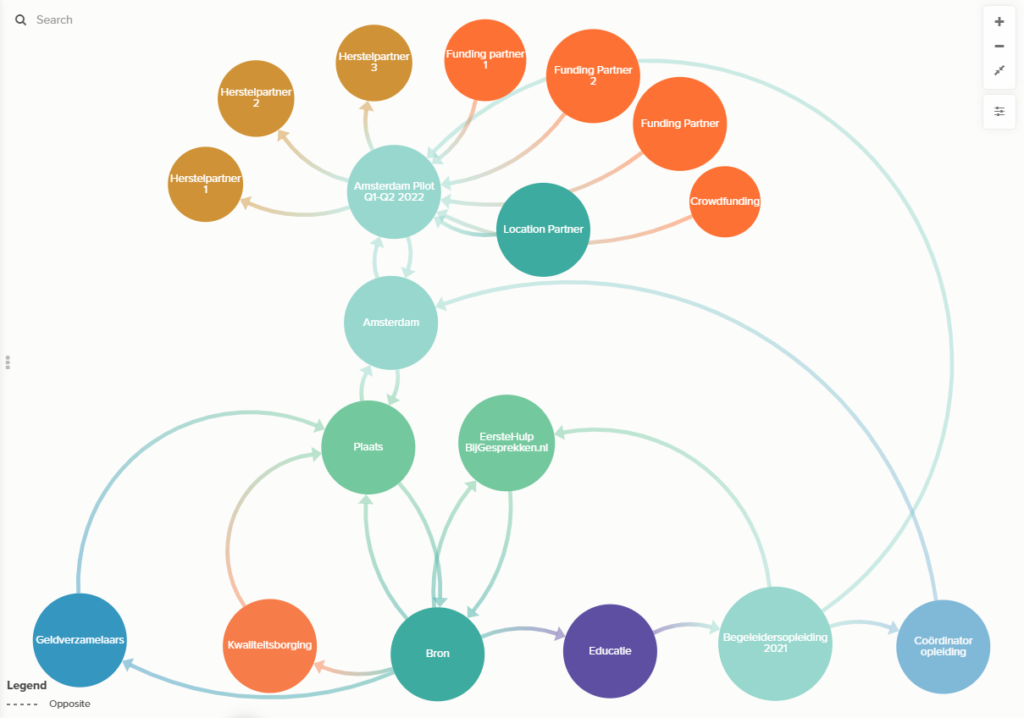
While I was creating the website for the Tiny Peace Office, I stumbled across www.kumu.io. This is the website I used to create the image above. I feel grateful to the people behind this service for helping me visualize the ideas that are in my head 🙂
Now my next steps are finding partners for the pilot in early 2022.
- One location partner
- Three funding partners
- Three restorative organizations that want to collaborate during the pilot in early 2022.
So if you have a direct contact with someone that might want to work together on the Tiny Peace Office, could you send me a message?
- Short Story: Ups & Downs
A couple of days ago, someone asked me:
I know you help people with solving conflicts and stuff, but I’m not in a conflict. I just want to practice how I can have more meaningful conversations in everyday life. Can you help me with that?
The question reminded me of the movie “The Big Lebowski.” In this movie “The Dude”, played by Jeff Bridges, gets asked how he’s doing. His response inspires me on a daily basis.
Just the other day, I was bumping into a neighbor and I asked how she was doing. She told me she was doing great. Then she asked me how I was doing.
My reply: “Ups & Downs.“
She almost immediately said: “Well actually, me too, I lost my job this week and I’m on a bit of a rollercoaster.”
We talked about her rollercoaster and then we talked a bit about my ups and downs. A real authentic conversation, on the street, with a neighbour. Just by changing “I’m doing great.” with “Ups & downs.“
Now, if you want more fun in your everyday conversations, you also have the option to change the first question you ask someone when you meet them. So instead of “How are you doing?” I often ask people something like this:
- How is your day going?
- How is your week going?
- How is life treating you?
- Anything weird happened today?
- Do you have anything to celebrate today?
- How’s your mood today?
Because these sentences are a little different from the common question, they help people pause to think about how they are “really” doing.
Which reminds me of a question I got from someone who was great at making meaningful connections in everyday life. First, she would ask people: “How are you doing?” Then she followed up by asking: “And how are you really doing?”
I guess my answer to the person who asked me the question this week, is something like this:
Pause to think about your first question and pause to think about your first reply, each time you meet someone.
- Cartoon: It’s not about you
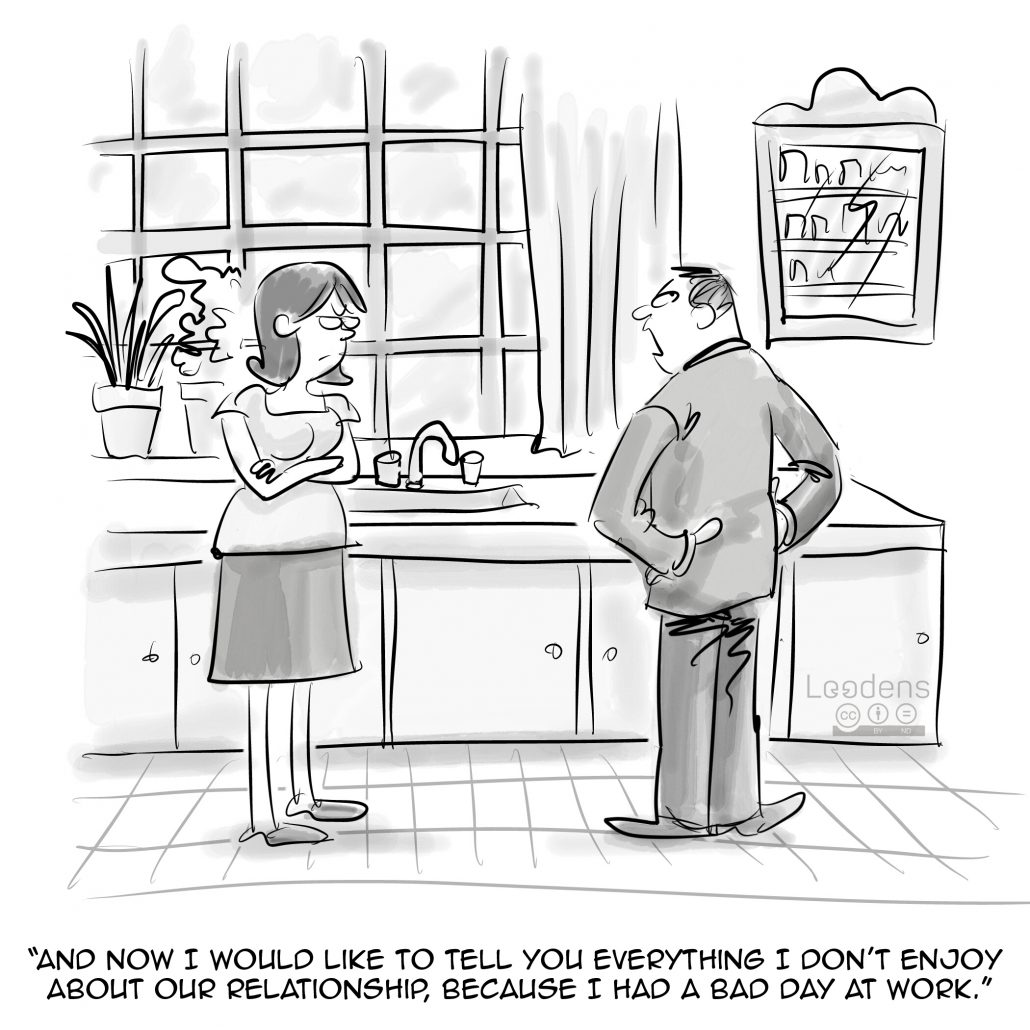
- Musing: What does nonviolence actually mean?
For the first thirty years of my life, I thought that nonviolence meant not hitting someone. I was pretty happy about never hitting anyone. I took pride in being a big guy and never using my physical power to hit someone.
Then I started studying nonviolence. At first, I thought that words could be violent. I tried to not use some words because I thought they would be violent.
Now, after six years of studying nonviolence, I’ve come to realize that nonviolence for me is foremost a state of being. In the book I co-wrote, illustrator Noushin made this image to illustrate this state of being:

Not making yourself lesser than or more than another human being, but to feel your own dignity and the dignity of the other person. In Dutch, there is a great word for this attitude: gelijkwaardig.
When we make ourselves lesser than or more than, we have an image of ourselves or the other person in our mind.
For instance; a colleague that is not replying to an email as soon as you’d like. The image you could have is that he’s out to get you and you paint the picture of a villain or a devil in your head.
😈
Or in a love relationship, you actually think the other person is amazing, like an angel. You do anything to please your partner and want to be like them.
😇
Or when you’re at the cash register and you’re not making real contact with the person behind the counter. You see them as a box. Something you can use to get what you want.
Instead of interacting with a real human being, we’re interacting with the image we have in our head of this other person. That, to me, is violence. Inner violence perhaps, but it usually results in outer violence.
For instance, in a love relationship, I have a tendency to idealize my partner and forget my own needs. After a while, I get angry at my partner for not taking me into account and I get us into a fight.
Or when I plan things for a project with other people, I oftentimes see the other person as a box that I can move around and make them do things for me. I forget that they are someone with free will, a family, and feelings. People stop liking to work with me and relationships break.
And when I don’t have enough money to get the things I want, I see others and the world as a devil, and myself as a victim. I stop using my talents, stop initiating things and I break down.As you can see, the state I’m in when I have these images in my mind are not fun states to be in. I’m suffering. And I stimulate suffering in others.
So that’s why I love to pause during the day when I notice these images. And transform them into something that is more fun and connecting. More free.
So nonviolence to me – right now – means: not to treat yourself or others as a devil, an angel, or a box.
I see this as a practice, and with practice, I can become better at it. With “it” I mean: being free of images that lead to suffering. Or as Gandhi put it:
We may never be strong enough to be entirely nonviolent in thought, word and deed. But we must keep nonviolence as our goal and make strong progress towards it.
I would like to add these words: with compassion for self and others.
Yeah, that’s the nonviolence I practice.
Do you want to practice with me? Give me a call to book an hour or a class – for free.
- Short story: I’m covering my ears like a kid
This afternoon I was working on a computer in the library. In the background there, were some kids playing with the furniture. They brought a smile to my face and they didn’t seem to disturb my focus so much.
But then, a woman came sitting next to me. A woman on the phone. She had plugged her USB-phone-charger into the computer next to me and was talking to – what seemed to be – a friend. She wasn’t using the computer, because she was focusing on her conversation.
I noticed that from this state of deep focus and flow, I started to feel a tension in my whole being when I heard her talking. There is something about only hearing one side of a conversation, that makes it hard to connect with someone. And actually, I hadn’t asked to connect with her or her conversation, I came here to focus on my work.
So at first, I tried to focus harder on my work.
Then I put my headphones in.
Then I put the volume of the music on my headphones to the max.
Only then I started checking in with myself.
What was I thinking?
“Shut the f*ck up! I’m working here!”
I felt my hands wanting to cover my ears.
What I needed was focus.
I already felt more peaceful. But she was still talking and I wasn’t able to focus.
So I connected to what she might be needing.
She needed to charge her phone.
By just connecting to that – pretty universal – need I completely relaxed. I thought:
“Of course, she sitting here at the only available computer; because she needs to charge her phone. Otherwise, she would’ve sat somewhere else.”
Or maybe she really liked me, but I doubt that. No, I think it was sitting next to me to charge her phone via the computer.
So instantly I grabbed my phone power adapter, the one that charges faster than a computer. I started walking around to see if I could find a place where she could talk with more comfort than next to me.
But as I was walking around I thought:
“No, I need to connect with her, I need her help to find something that works for both of us.”
So I walked around her, came down to a squat position so we were at eye-level and said:
“Excuse me, I would like to help you…”
She said to her friend:
“Hold on one moment.“
I continued:
“I would like to help you have a relaxed conversation and charge your phone…
She smiled and her eyes lit up.
“…and I need some help finding a way that I can also focus.”
I showed my power adapter and she said:
“Oh, how sweet, yeah let me go find another place, thank you so much for helping me.”
I smiled, she smiled, we connected.
And we both got our focus back 🙂
What I really like about this situation is that I started with the sentence: I would like to help you get what you want. I think I’m gonna use them more often.
What about you, what do you take away from this story?
- Update: €3.000 donation completes crowdfunding 🙂
Woohoo! Two months ago I started working along the principle of only doing things that I have enough support for. I created a crowdfunding page at www.eerstehulpbijgesprekken.nl to get financial support for my living expenses, during a 10 week course to train people to help solve conflicts.
Until Monday € 157,37 had been donated. And then – seemingly out of the blue – I got a call from an organization with the message that they’re willing to donate € 3.000,-
Wow, just wow.
This surprising gift, reminded me of this quote by Gandhi:
“If you don’t ask, you don’t get it“
I’m glad I asked…and very grateful that I have gotten the support I asked for.
Now that the crowdfunding has been successful, I see these next three steps:
- Promote: Make six videos with the help of producer Evert to give potential people an idea of the course.
- Support: Ask for another €1.000,- on the crowdfunding page, which will go to support producer Evert’s living expenses.
- Train: Create the first video for the 10 week course.
- Is this valuable to you?
Before my holiday break, I recorded eight videos with the help of Evert, Jeantilette and the hospitality of de Verbroerderij. These W.A.I.T. Why am I Talking? videos came out of pure inspiration, wanting to share my experience, to contribute to more nonviolence in this world, and to have a little fun 🙂
Now I’m curious if these experimental videos are valuable to others. So to help me be effective and to help find my next steps: could you watch one or more of these videos and tell me in the comments:
- one thing you like
- one thing you don’t like
- one idea you have for future videos
With gratitude and playfulness from Amsterdam-Noord.
- Support this community service
I give my conversations, classes, videos, books, cartoons, – well everything – away for free, as a community service. Because I like to live in a world where money is not an obstacle to get what you need. And because I receive so much by giving…so it feels weird to ask for money since I get so much out of it myself.
I’ve been working this way for 5 years now, and I’ve been able to help hundreds of people, with thousands of conflicts. I receive a lot of support from friends, family, my partner and a group of monthly donors. I also have a part-time job to pay some of my bills. I aim to be fully supported by donations by the end of 2022. I would love to receive $2.500 each month from 150-200 people. Do you want to be part of my support network and help me help those who need it the most, not necessarily the people who have the most money? You can try it out for 3 months, see how it feels. After three months the donation automatically stops and you’ll get an e-mail with the option to extend your support.
[paytium name=”Formulier naam” description=”Abonnement voor product of dienst” button_label=”I support Yves for 3 months”] [paytium_subscription interval=”30 days” times=”3″ /] [paytium_field type=”name” label=”Your Name” /] [paytium_field type=”email” label=”Your Email” required=”true” /] [paytium_field type=”label” label=”Choose your monthly amount” type=”open” /] [/paytium] - Cartoon: I just want him to open up first
An oldie, but a goodie
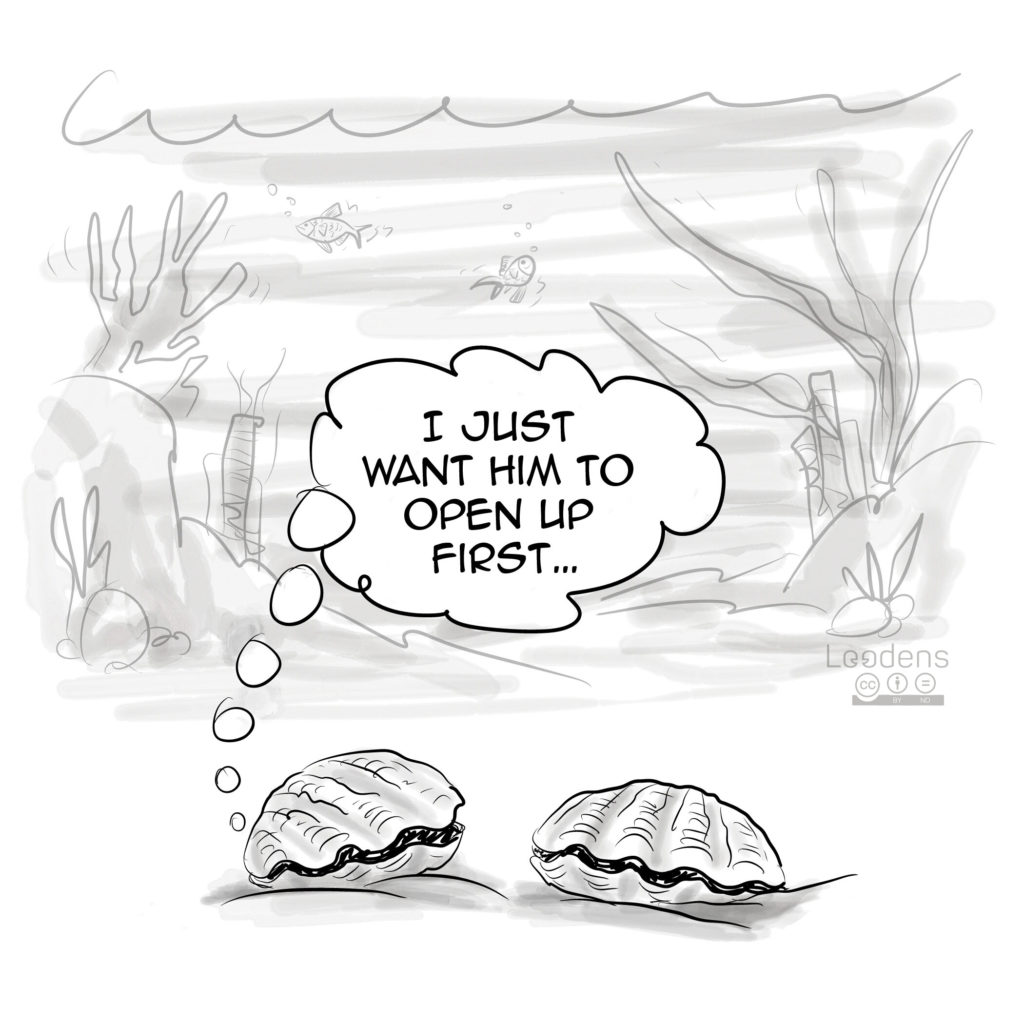
This cartoon I made with drawing help from a man in Malaysia, who works through the website Fiverr. This was the first ever cartoon that came to me. I was sitting in the kitchen of my then home in Boulder, Colorado. I had heard Brene Brown say earlier that week:
“Vulnerability is the last thing I want you to see in me, but the first thing I look for in you.”
That week I was also enjoying the New Yorker Complete book of Cartoons. The combination of the two helped spark this cartoon. Everything is a remix 🙂
- Download: Who do you find annoying?
A couple of weeks ago I spent a week with some old friends in Groveland, Massachusetts. As a small thank you gift for these American friends, I translated the Dutch poster, which I’ve got hanging on my bathroom door, into English.
What I really like about having this poster on the inside of my bathroom door, is that each time I leave the bathroom I’m not only feeling relieved physically, but also emotionally 😉
You can try it out yourself by clicking on the image, download the poster and print it out.
Will you let me know if it also helped you to find relief?
- Strategy update: Fall/Winter 2021
I’m back! After a month of reflection in the beautiful greenness of Costa Rica, I’ve received a clearer vision for the coming six months. Here are two main additions to the strategy that I wrote down two months ago in this post.
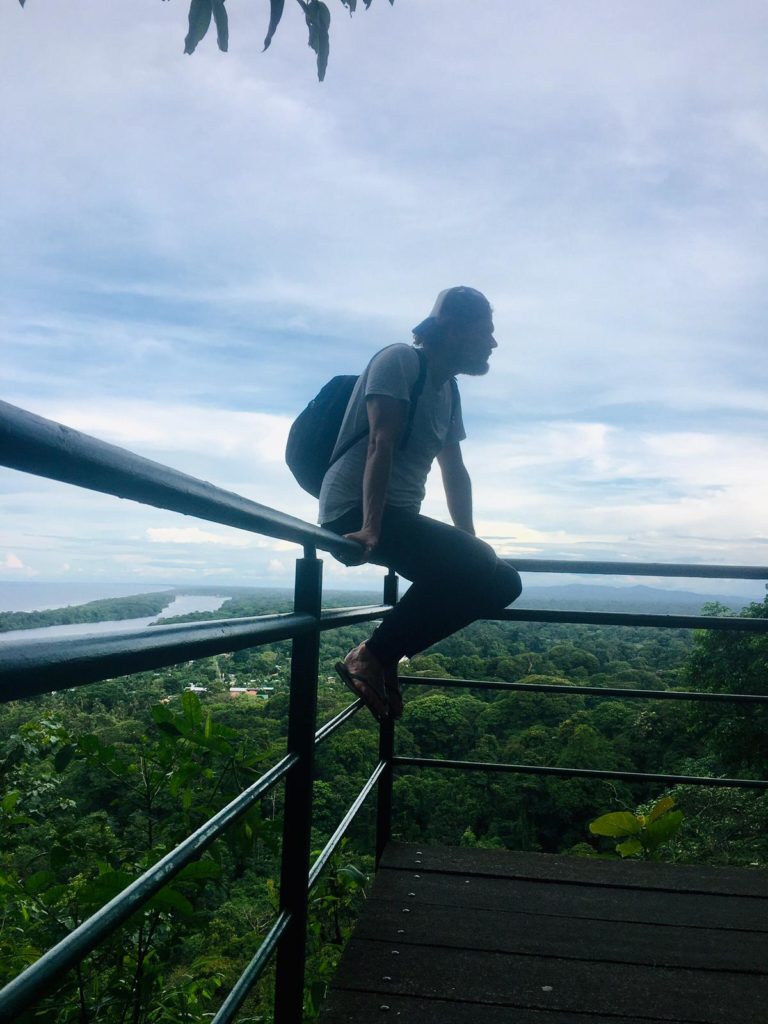
I’m offering a social service
I have a strong desire to keep operating in the gift economy. Gift economy means that I don’t throw up a paywall for people to access what I offer. I give things away for free.After a wonderful conversation with my friend Karolina and my new friend Ledvi, I realized that I need to focus more on receiving enough financial support for myself, to keep this radical principle of giving away my services to others alive.
They helped me see that what I’m offering is a kind of social service. Perhaps a community service.
I like the sound of that. Yes, what I offer – classes, conflict resolution conversations, educational material – is to support people in the community at large. I would love it if not the individuals that I support, but the community at large, would support me.
After this insight, I got the vision of receiving monthly financial support from 150-300 people who donate $5, $10 or $20 a month. This way I’m able to get the food, shelter, tools, focus and transportation I need, to be of best use to the community.
So what I’m focusing on these coming six months is to invite 200 people to give $5, $10 or $20 a month for three months. I’m adding a donation button to the top of this page and I will give a link to support me to all the people I support through conversations, classes and videos. Let’s see how it goes 🙂
Tiny peace office
The second addition to my strategy is the Tiny Peace Office. Last year I made a proposal – together with Mark and other people connected to Loodens – to go around Amsterdam in a Tiny House and offer 1.000 conflict resolution conversations and 50 classes. In Dutch this project is called Eerste Hulp bij Gesprekken.
Visual by Mark Goossens – no copyright The proposal got rejected by the people working for the different districts in Amsterdam. The three weaknesses that we identified in the proposal were:
- Not enough collaboration with other existing, local organisations.
- Not enough trust that what we offer is valuable and different from what other social services offer.
- Not enough support within our team to offer both on-demand support AND structural support.
Over the past month, I got excited again about collecting conflicts with this tiny peace office.
I want to learn from the weaknesses in our previous proposal and give the tiny peace office another shot. In the coming months I’m going to call around, to find support for a pilot project in the first quarter of 2022. To bring the Tiny Peace Office to a park in Amsterdam. The aim is to collect conflicts and help them get resolved. Either by me and my collaborators or by local partners who offer additional conflict resolution services.
I will keep you updated about this pilot here. Sign up for the newsletter to get the updates in your e-mail.
The existing strategy
The two topics above are additions to the strategy that I already wrote down about two months ago. Here’s in short what I’m planning to offer this fall and winter:- 1-2 classes a week
- 2-4 conversations a week
- 3-5 videos/stories a week
What was also a big part of the strategy and which stays the same, is my desire to be part of a team. So if you would like to work together with me, could you send me a message?
- UPDATE: August to reflect and relax, back in September

Seemingly out of nowhere, my girlfriend, family members, and friends pitched in to fly me to Costa Rica, then to Boston, and then back to Amsterdam.
I’m feeling grateful for this support and the opportunity to be with my girlfriend and her son in Costa Rica. After four weeks in Costa Rica, I’m going to Boston to reconnect with friends I haven’t seen in years.
So I’m taking the month of August off to reflect, relax and connect. I’ll be back, right here, at the beginning of September.
With a smile, from Tortuguero,
Yves
- Video: People are trying to sleep here!
In this video, we explore what we could say when we’re trying to sleep and some noise is preventing that from happening. With this video, we conclude the pilot phase of W.A.I.T. Why Am I Talking? We’re taking a month off from shooting videos, to ask for feedback. We want to learn if what we’re making is of value to people and what direction we can take this project in. In September I will report back with what we’ve learned from the feedback.
I could use your help and learn from your perspective, could you name one thing you like about the videos and one thing you would like to see more of in the coming videos?
- Video: That’s not what I said!
In this video we explore what you can say when you get into a right-wrong argument with a close one. Produced by Evert, script support by Jeantilette and with location support from de Verbroerderij.
- Cartoon: Psychotherapist
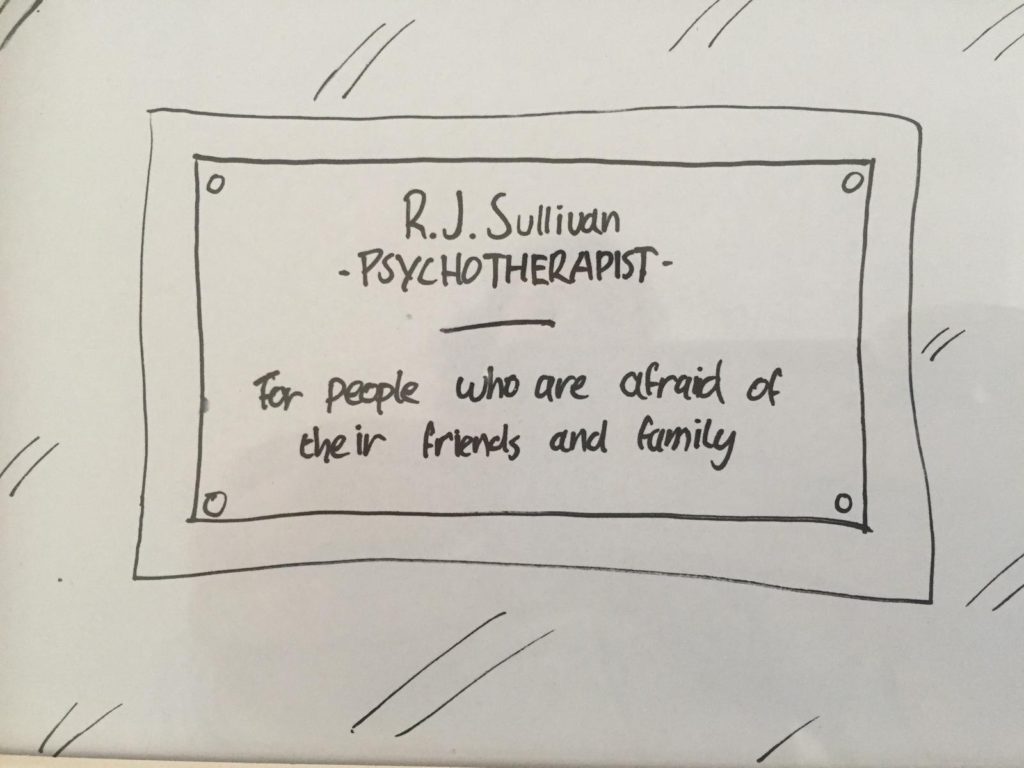
About six years ago I lived in Colorado in a house with two people who were licensed psychotherapists. One night I was reading a book I had found on a bookshelf, called “Save the cat“
The book is about a process for writing movie scripts. In one chapter de author describes the importance of having a logline: one sentence that describes the movie.
As I was reading the chapter one of my housemates walked into the room and I got the inspiration for this cartoon. I said: ” Psychotherapist: we help people who are afraid of their friends and family.”
We both laughed out loud. It was one of those laughs that starts out loud because the sentence uncovers a certain truth. After a couple of seconds, our laughter turned into a sigh, when we both felt the pain of this truth. Ouch.
Reminds me of someone who once said something along these lines: “When we think, we see the comedy. When we feel, we see the tragedy.“
- Video: “I don’t want to talk about it!”
Episode #6 of W.A.I.T. Why Am I Talking. It was fun to shoot in the forrest in Amsterdam-Noord. Again with the support of script editor Jeantilette, Editor and Director Evert and the people at de Verbroerderij who served us delicious toasties.
- Short Story: No need, no rush, no problem
Last week I was staying over at a friend with a broken arm. In the afternoon, she asked me if I could bring her bicycle into the garage. I said yes, to which she added:
“No rush”
We talked some more, about what I wanted for my birthday. I hadn’t thought about it and she said:
“Let me know when you figured out what you want for your birthday.”
The afternoon passed, the evening passed and when I was already laying in bed in the guestroom, I heard her say something about the bicycle not being in the garage.
I smiled and jumped out of bed. Walked outside, got the bicycle and put it in the garage.
When I got back I said:
“Now, I know what I want for my birthday: that you replace “no rush” or “no need” with what it is that you DO want.”
We both laughed and the next afternoon she even gave me the present, when she saw me cleaning the doormat. She said:
“No nee…uhm…thank you for cleaning!”
I smiled and got off to a restaurant where I was going to do some work. It was a hot day so I decided to get a cold 0% beer. The person behind the bar asked me if I wanted a glass with my bottle of beer. I replied:
“No nee…uhm…no thank you, I actually really love drinking out of the bottle, feels so fresh.”
The person behind the bar smiled and said: “Oh, yeah, I like it that way as well.” And we had a small and lively conversation.
The next day I wanted to treat myself to a sandwich in a small deli. When I showed my debit card, the man behind the counter asked:
“Do you also have cash?”
I looked at him.
He explainded: “Otherwise there’s a 0,30 cent surcharge, because the amount is so small.”
I said I didn’t have cash and add: “It’s no probl…uhm…I’d love to give you those 30 cents,” and smiled.
He smiled as well and replied:
“Then I’ll add some love to your sandwich.”
What I take away from these three encounters is that I get a smile and a little bit of love, each time I replace no need, no rush, or no problem, with what it is that I DO want 🙂
Photo by Collin Key Creative Commons-attribution-nonommercial-sharealike
- Video: “Oh no, there we go again…”
Episode #5 of W.A.I.T. Why Am I Talking. Very grateful for the support of script editor Jeantilette, director and editor Evert and the peeps at de Verbroerderij for offering their space to us.
- Cartoon: The eternal miscommunication
For years, people have been helping me to make ideas that I have into cartoons. I’m very grateful for their help 🙂
Last night I wanted to see if I could draw one myself. I watched a Youtube video on how to draw cartoons and here’s the result that I made on an iPad. Here’s to being a beginner again.
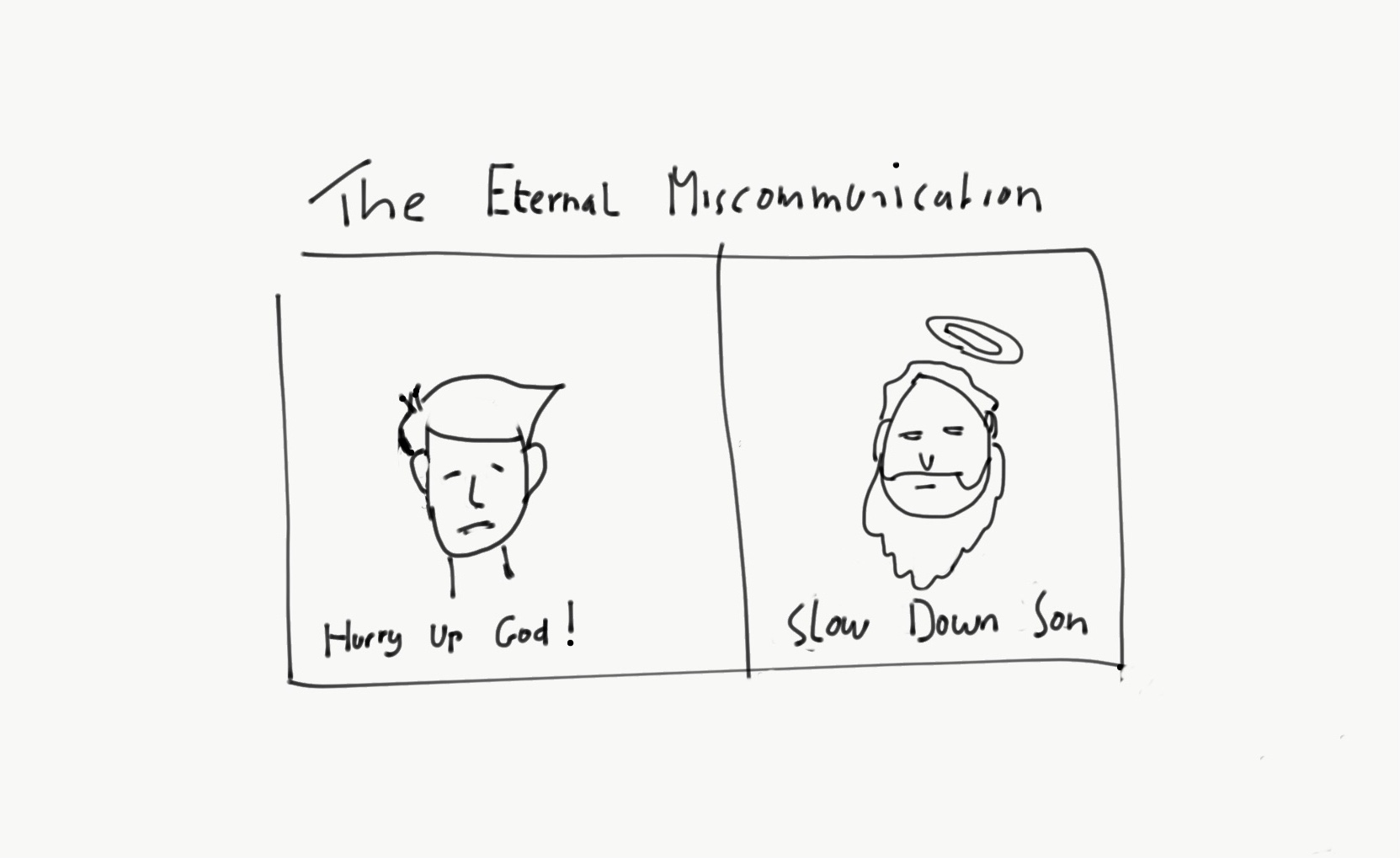
- Video: What if you think someone’s a bitch?
Here’s W.A.I.T. Why Am I Talking video #4 that I recorded with Evert. He edited the video as well and Jeantilette helped creating the script for this video. We were shooting in the greenhouse of “De Verbroerderij“. Many thanks to all of you _/|\_
- Short story: Practicing Being an Active Bystander
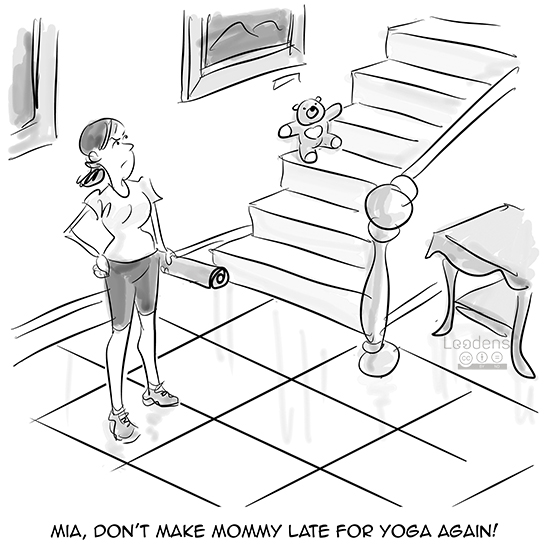
Yesterday I was in a nice flow on my bicycle. I had timed it perfectly: I picked something up in the west of Amsterdam, I would bicycle back to the east, just in time for my weekly meditation group.
I was about halfway when I contemplated crossing a red light, at a crossing where there were no cars waiting for the stop signs. As I was approaching the crossing I noticed a police officer on a motorbike stopping a hundred yards from the traffic light. There was my answer. I stoppped for the red light.
And then I watched a man, with a food delivery bag on his shoulders, cross the red light. It must have been three seconds later when I saw the police officer drive by to go after him.
Everything inside me screamed: “No”. Over the past couple of months I have talked to a bunch of people who deliver food and in each conversation it seems that these people already have a rough time in our society. They don’t need another setback.
Without really thinking, I went after the two. After two blocks I caught up with them, they were both standing on a busy square in downtown Amsterdam. The man appeared to have his roots in an Asian country like India, pretty slender and not much bigger than 5″4′. He appeared to be scared and was apologizing to the office. In a kind of rambling way he explained that he is just a tourist here.
The police officer was more like my size, 6″3′ and with his motorbike and all of his gear, there was a stark contrast between the two.
I got off my bike and – I must admit – was not in a state of nonviolence yet. So I said to the delivery man:
“Whatever the fine is, I’ll pay for it. Because I think there are more effective ways than this to deal with this situation.”
The police officer turned to me and said with a voice that sounded more like a military office:
“Can you please just let me do my work, understood!?”
I was boiling inside. Usually I’m pretty spacious in these situations, but because of the adrenaline from the bike ride – remember: I was rushing to get to my weekly meditation in time – plus the sadness that must have been building up into anger from seeing the systemic ways in which people of color or people with less priviliges than I are being treated, must have formed a violent cocktail inside of me.
But this energy also helped me to at least stand up and speak up, instead of remaining passive. So I said to the police office:
“Could you let me know what it is that I do that is getting in the way of your work?”
The police office said:
“Well, you’re talking to him and that is preventing me from having a conversation with him.”
I could see his point. And I started to see him more as a human being than before. But then, with the same tone as before he asked me the question, that didn’t sound like a question, but more like a demand.
“So could you just let me do my work, understood?!”
Now, I had landed sufficiently to have respect for his needs, as well as my own, and also for the man who got pulled over. So I said:
“Well, I want to ask if that is OK with him. So I asked the man with the food delivery bag:
“I would like to help you, would you like my help?”
The man said: “yes.” I explained to him what the officer had said in Dutch to me:
“So the police officer would first like to talk to you and then after we can talk so I can see where I can help you.”
He was happy with this.
As I was listening to the police officer talking to him, I realized why the man was more scared than I would be, when I would be fined for crossing a red light.
It turned out he only had a visa for Italy, not for The Netherlands.
His breath became shallower and his eyes more fearful.
At that point I was wondering: how can I support him?
As the police officer was looking things up in his computer, I said to the man: “I can imagine you’re feeling nervous and scared.”
He nodded.
Then I put my hand on my heart and said that I would breath with him.
Then he put his hand on his heart.
And while the police officer was doing his thing, the man and I were standing there, breathing together on a busy square in downtown Amsterdam. I felt so peaceful and connected.
After a minute or two the police officer started to explain things to the man in English, which sounded more like Denglish: a combination of Dutch and English.
The man didn’t seem to understand him and I helped the police officer with the translation. The police officer thanked me and actually started to smile. I could sense him relax more as well.
I had put my hand off my heart – being the translator and all – and continued to help them understand each other. The police officer said:
“This time I’m going to let you off with a warning for crossing the red light. You have to go to the immigration office to report yourself. If I catch you again I will arrest you and bring you to the immigration police.”
The man sighed with relief, I sighed with relief and the police officer thanked me, I thanked him. The man with the food delivery bag thanked the police officer as well, as he drove off on his motorbike.
As the two of us were left standing there, the man explained that he had had a horrible life in Bangladesh and had fled to Italy, but due to the epidemic, life had become horrible over there as well. So he was staying with a friend – illegaly – here in Amsterdam to wait until the worst was over.
He told me he was so grateful. At first he thought that I was also against him, but when I said I wanted to help, he was feeling really supported and more relaxed. Not alone anymore.
I felt grateful that I was able to contribute and we both smiled.
We talked some more and I started to reflect on my action.
I said:
“I guess the only thing I wanted was to support you in a situation when you have less power than the other person. And to bring the humanity into the system. Whatever the outcome is.”
As I’m writing this story I’m grateful for the two facilitators who gave me a class in active bystander training this year. They helped me see that just being present with someone and offering your help, can be enough to stop harrasment and power-over-dynamics.
The next time I want to bring more humanity and respect to the police officer. Or someone else with structural power. Straight from the start. By saying something like: “I want to respect your work and I also want to support him. Do you have any objections against me asking if he wants my support?”
In the end I missed the group meditation. Although, now that I’ve come to think about it: maybe two guys with their hands on their hearts, breathing together, with a police office who gives us a smile, that sounds a lot like a group meditation.
- Project Update: Start Crowdfunding Facilitator Course
Today I’m celebrating the start of a crowdfunding campaign to get enough support for a 10-week facilitator course: www.eerstehulpbijgesprekken.nl
What I’m particularly celebrating are two things.
1. Only do things that I have support for
As I wrote in my strategy for the fall and winter, I want to be part of a team that works together on a daily basis: a nonviolent A-Team. My tactic to achieving this is to support people in learning the structure and practices that I use to help people solve a conflict. After this educational period, I would like a couple of these people to stick around and work together with me on a daily basis towards a shared dream.
I got the idea to start a 10-week course to share what I’ve discovered with people who have a desire to solve conflicts in themselves AND to help others to solve conflicts.
What I used to do when I got ideas for a new project, was just offer it and wait for people to come. Sometimes this worked, oftentimes this didn’t work.
This time I wanted to work with the principle to only do things I have support for. So first I did a survey on Facebook to ask what people wanted me to do next. I gave them three options I was excited about.
The 10-week course got the most votes, so I knew that what I was longing for, was also something some people were longing for.
2. Work with money in a more wholesome way
But then the issue arose: how am I going to get enough financial support while also making the course freely accessible. I want to give my work away freely, because I have seen the conflicts that arise from the mainstream way of going about money and I want to offer a more wholesome alternative.
Then I got the idea of starting a crowdfunding campaign.
This way people who want the course to happen can make it happen, which already gives me a sense of togetherness. And – if I get enough support to be able to focus most of my energy on this course – the people who are eventually taking the course, don’t need to pay anything for it.
I love this way of working.
This line from Martin Luther King’s Letter from a Birmingham Jail comes to mind:
“Nonviolence demands that the means we use must be as pure as the ends we seek.“
About me
support, direction and contact
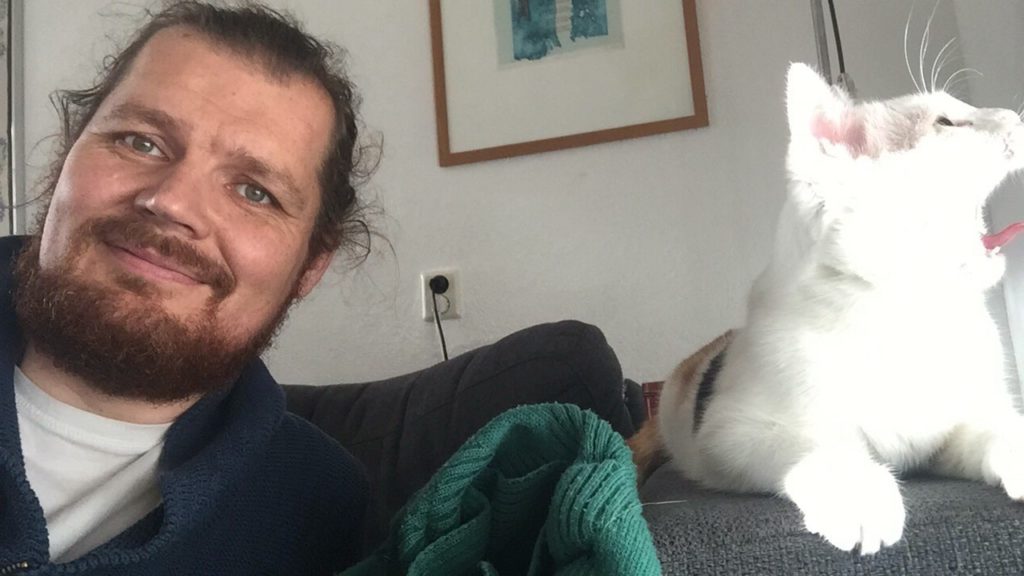
Hi, I’m Yves from Amsterdam. On this page I share updates on my efforts to contribute to more nonviolence in the world.
You can reach me at yves@loodens.org or via phone, whatsapp or signal: +31 6 14189776
You can signup to receive the updates on this website via e-mail.
There are three main projects that I work on:
– Educational and emotional support system Loodens – Live
– Restorative support system Eerstehulpbijgesprekken.nl – Pilot phase
– Communal support system Draagkracht – Research phase
I give my time, energy and anything I produce away for free, because I like living in a society where money isn’t getting in the way of what you need. I get support for my daily living expenses from my friends, family, and people like you through donations:
[paytium name=”Formulier naam” description=”Abonnement voor product of dienst” button_label=”I support Yves for 3 months”] [paytium_subscription interval=”30 days” times=”3″ /] [paytium_field type=”name” label=”Your Name” /] [paytium_field type=”email” label=”Your Email” required=”true” /] [paytium_field type=”label” label=”Choose your monthly amount” type=”open” /] [/paytium]If you want to invite me to a group of people, an easy way to do this is a 3 hour introduction class called: “Anger for Dummies/Boos worden voor Beginners”.
Requests for support
There are many ways – outside of money – in which you can support me:
Support for Loodens
– 1-2 days a week support with recording and editing videos for two educational projects. Fulfilled by Evert & Jeantilette
– 2 people to assist weekly class on Monday evening in Amsterdam.
– A van/mobile home to travel around the Netherlands teaching and to have fun with 🙂
Support for Eerste Hulp bij Gesprekken.nl
– A pool of 3 people editing daily posts on this website. Approximately 1 hour a week per person.
– 1 person for bi-weekly coaching call on strategy
Fulfilled by Ike
– A pool of 30 people for proofreading and watching videos I create for EHBG-facilitators.
Partially fulfilled by Jantine & Hanna
– 2-3 people distributing and managing the EHBG-card on toilets around The Netherlands.
– 2 people who want the role as counselor/vertrouwenspersoon to actively ask my environment for feedback on my behavior and for people to come for help when their trust in me has been damaged.
– 1 person to work together on a daily basis to start the Tiny Peace Office with and co-create fundraising.
Support for Draagkracht
– 2 people who want to do field research with me and get the project to a pilot phase.
